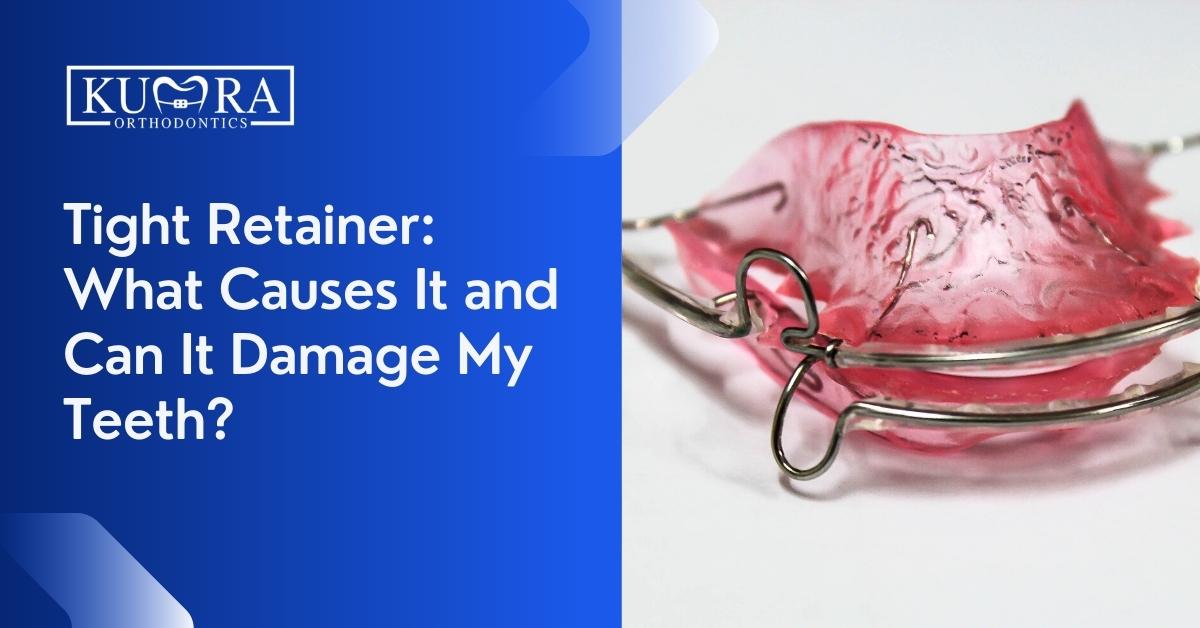Undertaking an orthodontic journey can sometimes feel like navigating through uncharted territory. The experience can be filled with surprises and questions, particularly when you encounter unexpected issues such as a tight retainer. If you’ve found yourself in this predicament, you’re not alone. This is a common concern amongst many orthodontic patients, and we’re here to demystify it.
In our comprehensive guide, Tight Retainer: What Causes It and Can It Damage My Teeth?, we delve deep into this topic. We aim to provide you with a clear understanding of why your retainer might feel uncomfortably tight, the implications it could have on your teeth and gums, and what actions you should take to rectify the situation.
Whether you’re a newcomer to wearing a retainer or a seasoned user, this article aims to arm you with valuable knowledge and insights. Our goal is to ensure that your orthodontic journey is not only smooth but also as effective and comfortable as possible. So, let’s dive in and unravel the mystery surrounding tight retainers.
Understanding How Retainers Work
Retainers are a critical component of the orthodontic journey, often introduced after you have undergone a successful orthodontic treatment such as braces. These custom-made dental appliances are expertly designed to fit your mouth perfectly and play an essential role in preserving the alignment of your teeth.
After your teeth have been corrected and repositioned through orthodontic treatment, your gums and bones need time to adapt to these new changes. This is where retainers come into play – they hold your teeth firmly in their new positions, giving your gums and bones ample time to adjust.
The primary goal of a retainer is to counteract the natural tendency of your teeth to gradually shift back into their original positions over time. This phenomenon, known as relapse, can potentially undo the hard-won results of your orthodontic treatment. By wearing a retainer as instructed by your orthodontist, you can effectively maintain a straight, aesthetically pleasing smile for years to come.
Regardless of the type, each retainer is meticulously crafted to fit your mouth with precision. They act as vigilant guardians of your smile, ensuring that the effort, time, and financial investment you’ve made in your orthodontic treatment yield enduring results. By faithfully wearing your retainer, you can enjoy the benefits of a beautiful, straight smile long after your braces come off.
Needing an orthodontic appointment?
Visit Kumra Orthodontics Washington, DC or Kumra Orthodontics Stafford, VA, and request an appointment with us!
Yes, Retainers Can Damage Your Teeth
Despite the crucial role retainers play in preserving the alignment of your teeth post-orthodontic treatment, it’s important to note that they can potentially cause damage if misused. Let’s explore three key scenarios where this could occur:
Dealing with Overly Tight Retainers
An overly tight retainer can exert unnecessary pressure on your teeth and gums. This relentless force can lead to discomfort and, in some cases, result in gum recession. In severe situations, it can even cause tooth mobility or loss. Therefore, it’s essential to ensure your retainer fits well without causing undue strain on your oral structures.
The Impact of Poor Oral Hygiene
A retainer that isn’t cleaned properly or frequently can quickly become a haven for bacteria. This can escalate into various oral health issues such as tooth decay, gum disease, and even bad breath. Hence, it’s of utmost importance to clean your retainer as per the instructions provided by your orthodontist, ensuring good oral hygiene.
The Risks of Long-term Wear Without Supervision
Wearing a retainer for an extended period without regular orthodontic check-ups can invite trouble. Given that your mouth continually evolves and grows – especially during the adolescent phase – unmonitored changes can result in the retainer no longer fitting properly. This can cause discomfort or even lead to tooth misalignment.
Regular visits to your orthodontist can help monitor these changes, ensuring that your retainer continues to serve its purpose effectively, enhancing rather than harming your smile.
How to Know if Your Retainer Doesn’t Fit?
Recognizing whether your retainer doesn’t fit properly is crucial for maintaining your orthodontic health. Here are a few signs that may indicate a problem:
Unusual Discomfort
While it’s normal to experience some discomfort when you first start wearing a retainer, persistent or increasing pain could be a sign that your retainer doesn’t fit correctly. If the discomfort continues beyond the initial adjustment period or it suddenly starts after a period of comfort, it might be time to consult with your orthodontist.
Difficulty in Inserting and Removing the Retainer
A well-fitting retainer should not pose any significant challenges when it comes to insertion or removal. This dental appliance is designed to fit snugly yet comfortably around your teeth, ensuring ease of use during these routine processes.
However, if you find yourself wrestling with your retainer during insertion or removal, this could be a red flag indicating a poor fit. Struggling to place or remove your retainer not only makes the experience uncomfortable but may also increase the risk of damaging the appliance or injuring your mouth.
Noticeable Shifting of Teeth
The primary objective of a retainer is to maintain the alignment of your teeth post-orthodontic treatment. It serves as a barrier against the natural tendency of teeth to revert to their original positions.
Therefore, if you start to notice any shifting or movement in your teeth, it could be an alarming signal that your retainer isn’t fitting correctly or performing its job effectively. This shifting might manifest as subtle changes in the way your teeth align when you bite down, or you may even notice visible displacement in the mirror.
Knowing When to Get Retainers Adjusted
Understanding when to get your retainer adjusted can help prevent unnecessary discomfort and potential dental issues. Here are some instances when you should consider getting an adjustment:
Recent Dental Procedures
If you’ve recently undergone a dental procedure such as getting a filling or having a crown placed, this could potentially alter the fit of your retainer. These procedures can cause subtle changes in the shape and structure of your teeth, which may make your previously well-fitting retainer feel tight or uncomfortable.
In such instances, it’s crucial to consult with your orthodontist or dentist. They can check the fit of your retainer and make necessary adjustments to ensure it continues to serve its purpose without causing discomfort or potential damage to your teeth.
Changes in Fit Over Time
Our bodies are constantly changing and evolving, and our mouths and teeth are no exception. As we age, our jawbone changes and our teeth may shift slightly. This natural evolution can impact how your retainer fits.
If you notice that your retainer has become increasingly uncomfortable, or if it doesn’t seem to fit as snugly as it once did, it’s likely time for an adjustment. Don’t ignore these changes; timely intervention can prevent potential issues such as tooth misalignment from reoccurring.
Damage to the Retainer
If your retainer gets damaged, it won’t fit correctly, and it may even cause harm to your teeth or gums. Any cracks, chips, or other visible damage are clear signs that you need to have your retainer adjusted or replaced.
In light of these insights, we implore you to take a proactive stance towards your orthodontic health. Should you experience any discomfort, difficulties, or noticeable changes with your retainer, seek professional advice immediately to prevent any potential mishaps.
Tight Retainer FAQs
Can a tight retainer straighten teeth?
A tight retainer is meant to maintain teeth alignment post-orthodontic treatment, not to correct major misalignments. If your teeth have significantly shifted, consult your orthodontist, as you might need additional treatment.
Why do my retainers feel tight every night?
Retainers may feel tight at night due to daily teeth shifts, especially if not worn regularly. The tightness is the retainer realigning your teeth. If it’s uncomfortable, consult your orthodontist for possible adjustments.
Do retainers loosen over time?
Retainers can loosen due to wear and natural oral changes. Regular check-ups with your orthodontist are necessary to ensure your retainer fits correctly and maintains the alignment of your teeth.
Read More: Can Invisalign Fix TMJ Problem?
Protect Your Smile with Kumra Ortho
Don’t wait another day to give your smile the care it deserves. At Kumra Ortho, your trusted orthodontist in Washington, DC, we’re dedicated to providing top-notch orthodontic solutions that will keep your teeth healthy and your smile bright.
Whether you need braces, retainers, or just a routine check-up, our team of experienced professionals is here to help. So why wait? Protect your smile with Kumra Ortho today. Book your appointment now, and let us guide you on your journey to a healthier, happier smile.



